Entrepreneurship: Starting a Business in Australia
VerifiedAdded on 2023/04/21
|12
|2247
|321
AI Summary
This document provides information on starting a business in Australia, including the process of registering a business name, incorporating a company, renting office space, opening a bank account, and necessary furnishings and costs. It also explores the justification for a fruit juice business venture, target market, competition and risks, estimated capital and costs, and preferred business location in Sydney. Additionally, it provides information about pearls in Australia, including the pearl capital, wholesalers, types of pearls, determining prices, and end products.
Contribute Materials
Your contribution can guide someone’s learning journey. Share your
documents today.
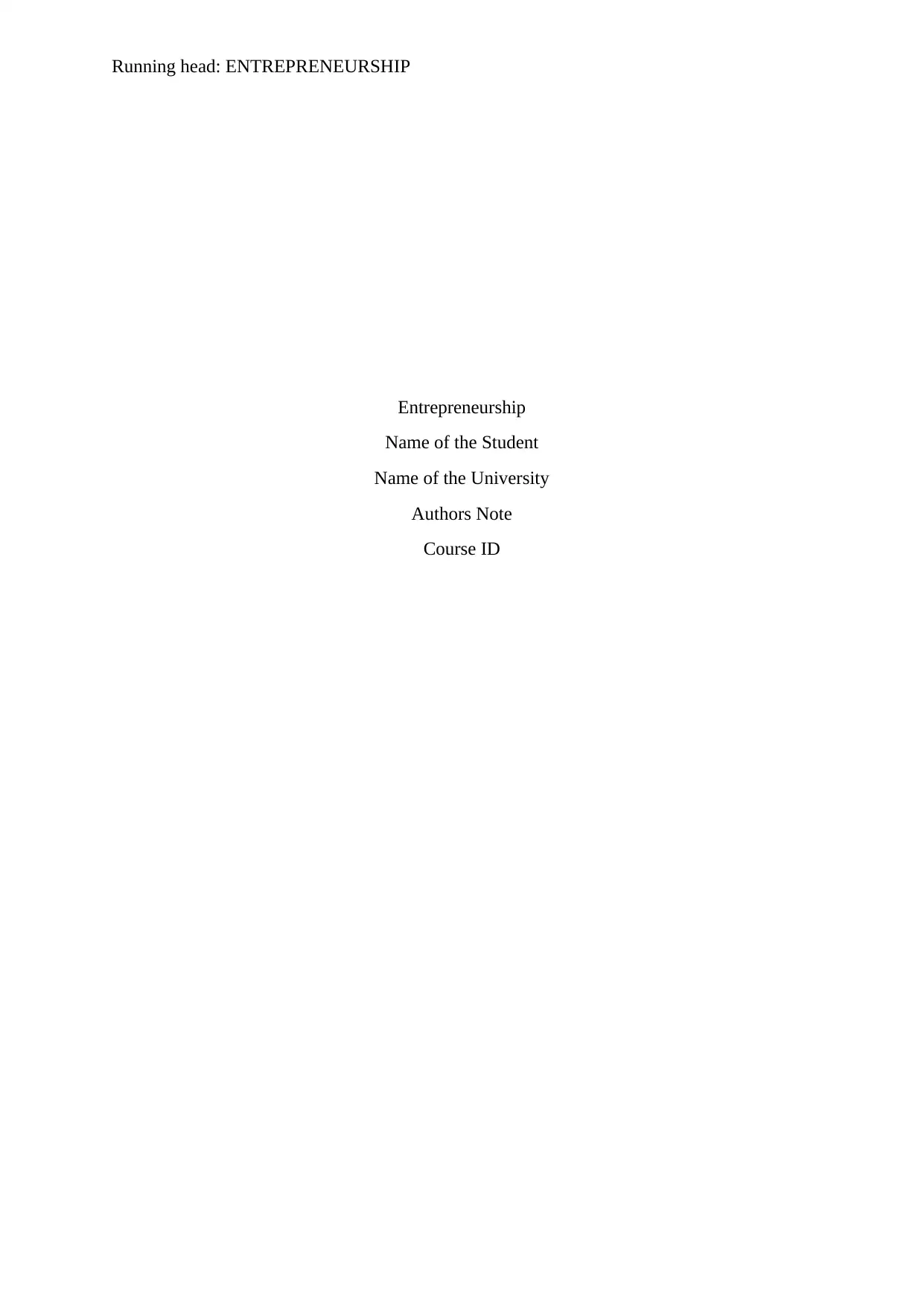
Running head: ENTREPRENEURSHIP
Entrepreneurship
Name of the Student
Name of the University
Authors Note
Course ID
Entrepreneurship
Name of the Student
Name of the University
Authors Note
Course ID
Secure Best Marks with AI Grader
Need help grading? Try our AI Grader for instant feedback on your assignments.
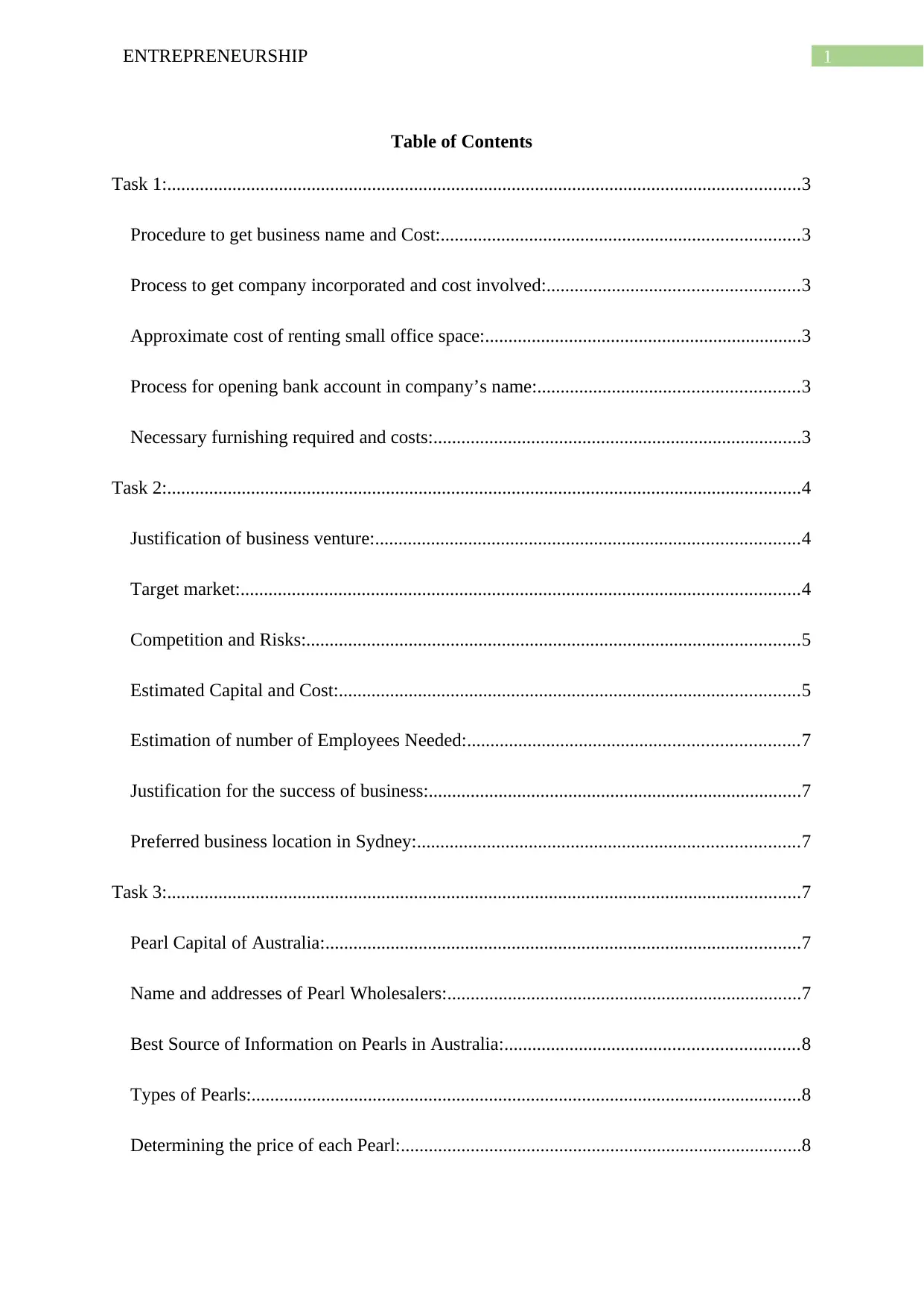
1ENTREPRENEURSHIP
Table of Contents
Task 1:........................................................................................................................................3
Procedure to get business name and Cost:.............................................................................3
Process to get company incorporated and cost involved:......................................................3
Approximate cost of renting small office space:....................................................................3
Process for opening bank account in company’s name:........................................................3
Necessary furnishing required and costs:...............................................................................3
Task 2:........................................................................................................................................4
Justification of business venture:...........................................................................................4
Target market:........................................................................................................................4
Competition and Risks:..........................................................................................................5
Estimated Capital and Cost:...................................................................................................5
Estimation of number of Employees Needed:.......................................................................7
Justification for the success of business:................................................................................7
Preferred business location in Sydney:..................................................................................7
Task 3:........................................................................................................................................7
Pearl Capital of Australia:......................................................................................................7
Name and addresses of Pearl Wholesalers:............................................................................7
Best Source of Information on Pearls in Australia:...............................................................8
Types of Pearls:......................................................................................................................8
Determining the price of each Pearl:......................................................................................8
Table of Contents
Task 1:........................................................................................................................................3
Procedure to get business name and Cost:.............................................................................3
Process to get company incorporated and cost involved:......................................................3
Approximate cost of renting small office space:....................................................................3
Process for opening bank account in company’s name:........................................................3
Necessary furnishing required and costs:...............................................................................3
Task 2:........................................................................................................................................4
Justification of business venture:...........................................................................................4
Target market:........................................................................................................................4
Competition and Risks:..........................................................................................................5
Estimated Capital and Cost:...................................................................................................5
Estimation of number of Employees Needed:.......................................................................7
Justification for the success of business:................................................................................7
Preferred business location in Sydney:..................................................................................7
Task 3:........................................................................................................................................7
Pearl Capital of Australia:......................................................................................................7
Name and addresses of Pearl Wholesalers:............................................................................7
Best Source of Information on Pearls in Australia:...............................................................8
Types of Pearls:......................................................................................................................8
Determining the price of each Pearl:......................................................................................8
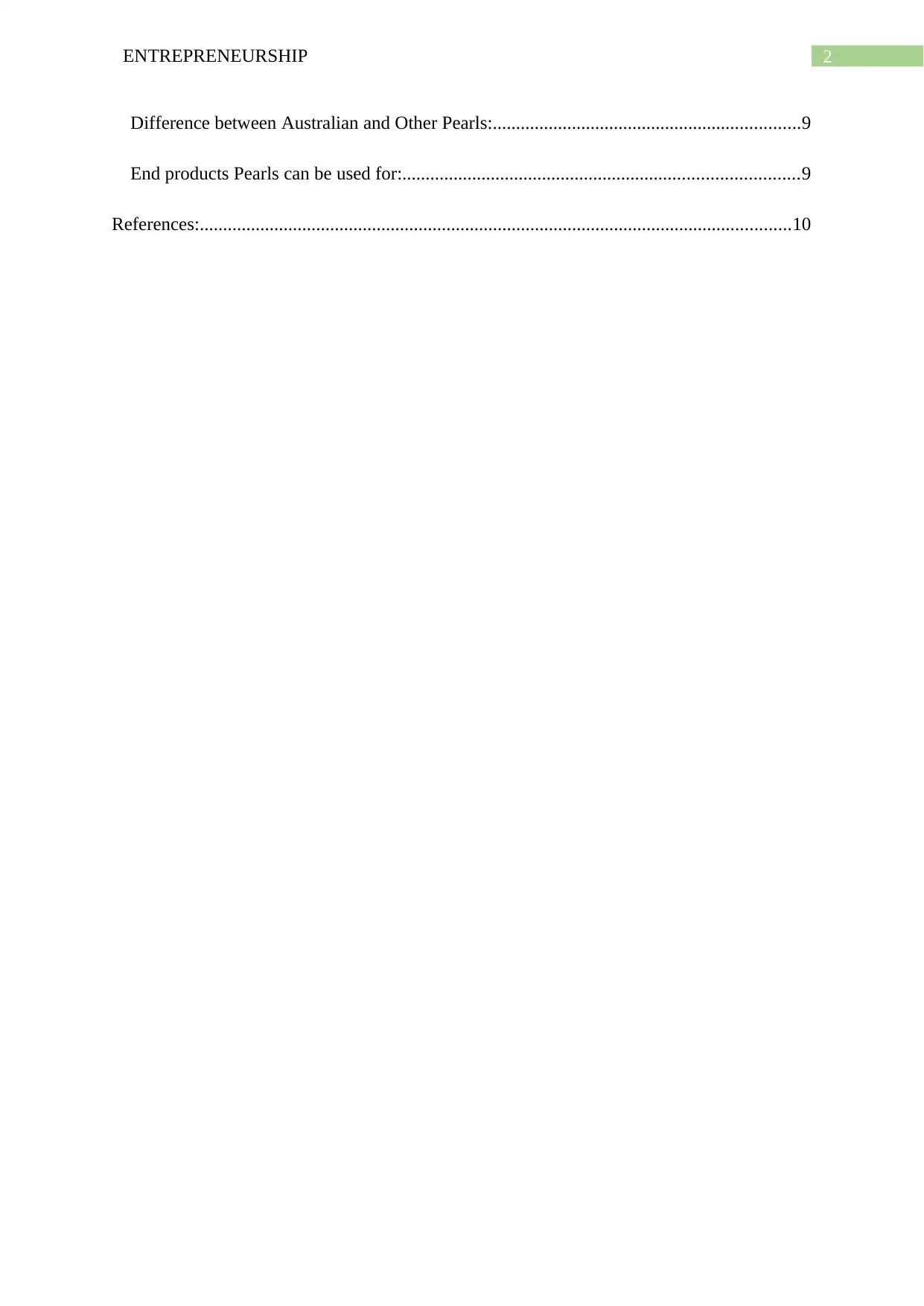
2ENTREPRENEURSHIP
Difference between Australian and Other Pearls:..................................................................9
End products Pearls can be used for:.....................................................................................9
References:...............................................................................................................................10
Difference between Australian and Other Pearls:..................................................................9
End products Pearls can be used for:.....................................................................................9
References:...............................................................................................................................10
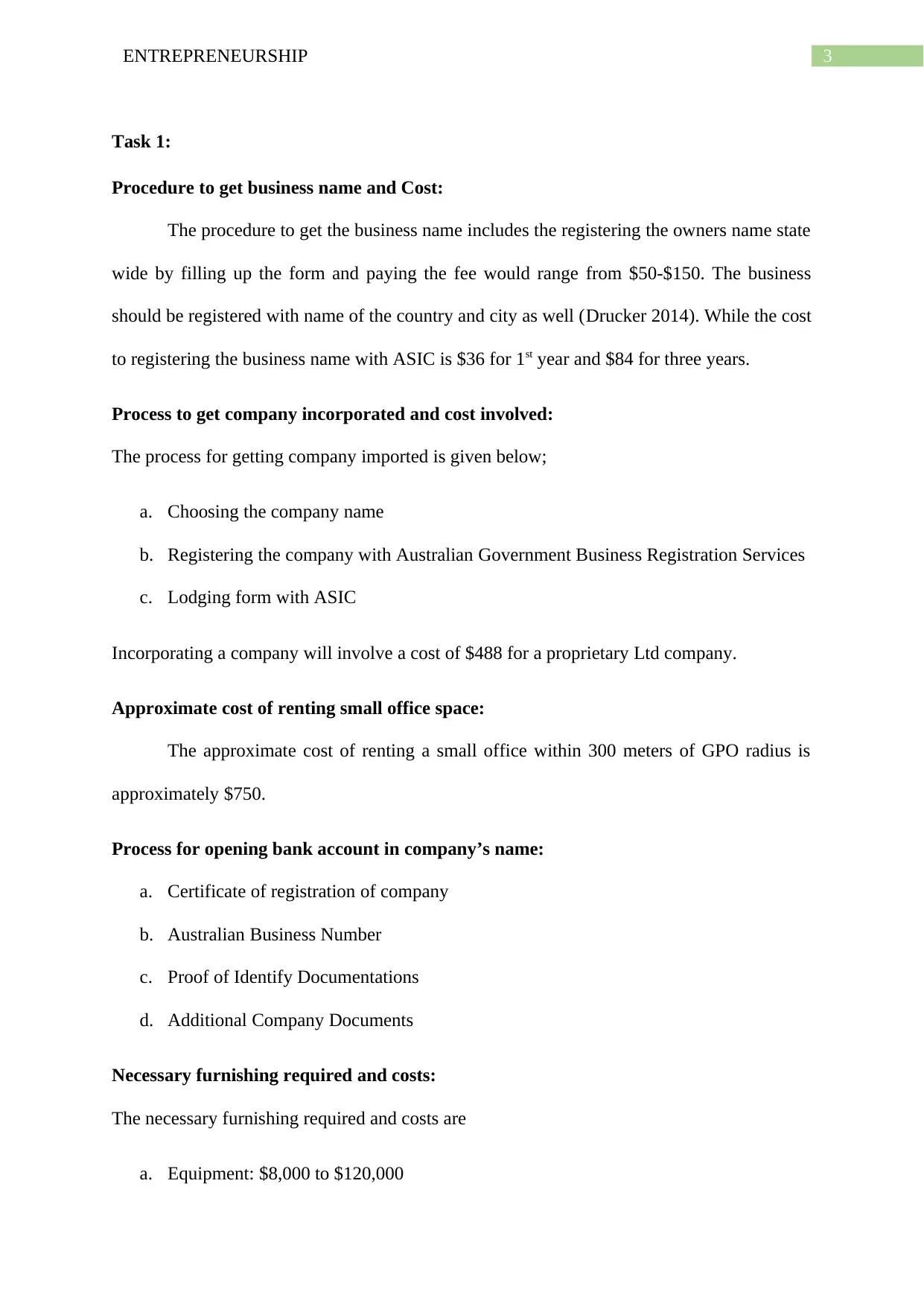
3ENTREPRENEURSHIP
Task 1:
Procedure to get business name and Cost:
The procedure to get the business name includes the registering the owners name state
wide by filling up the form and paying the fee would range from $50-$150. The business
should be registered with name of the country and city as well (Drucker 2014). While the cost
to registering the business name with ASIC is $36 for 1st year and $84 for three years.
Process to get company incorporated and cost involved:
The process for getting company imported is given below;
a. Choosing the company name
b. Registering the company with Australian Government Business Registration Services
c. Lodging form with ASIC
Incorporating a company will involve a cost of $488 for a proprietary Ltd company.
Approximate cost of renting small office space:
The approximate cost of renting a small office within 300 meters of GPO radius is
approximately $750.
Process for opening bank account in company’s name:
a. Certificate of registration of company
b. Australian Business Number
c. Proof of Identify Documentations
d. Additional Company Documents
Necessary furnishing required and costs:
The necessary furnishing required and costs are
a. Equipment: $8,000 to $120,000
Task 1:
Procedure to get business name and Cost:
The procedure to get the business name includes the registering the owners name state
wide by filling up the form and paying the fee would range from $50-$150. The business
should be registered with name of the country and city as well (Drucker 2014). While the cost
to registering the business name with ASIC is $36 for 1st year and $84 for three years.
Process to get company incorporated and cost involved:
The process for getting company imported is given below;
a. Choosing the company name
b. Registering the company with Australian Government Business Registration Services
c. Lodging form with ASIC
Incorporating a company will involve a cost of $488 for a proprietary Ltd company.
Approximate cost of renting small office space:
The approximate cost of renting a small office within 300 meters of GPO radius is
approximately $750.
Process for opening bank account in company’s name:
a. Certificate of registration of company
b. Australian Business Number
c. Proof of Identify Documentations
d. Additional Company Documents
Necessary furnishing required and costs:
The necessary furnishing required and costs are
a. Equipment: $8,000 to $120,000
Secure Best Marks with AI Grader
Need help grading? Try our AI Grader for instant feedback on your assignments.
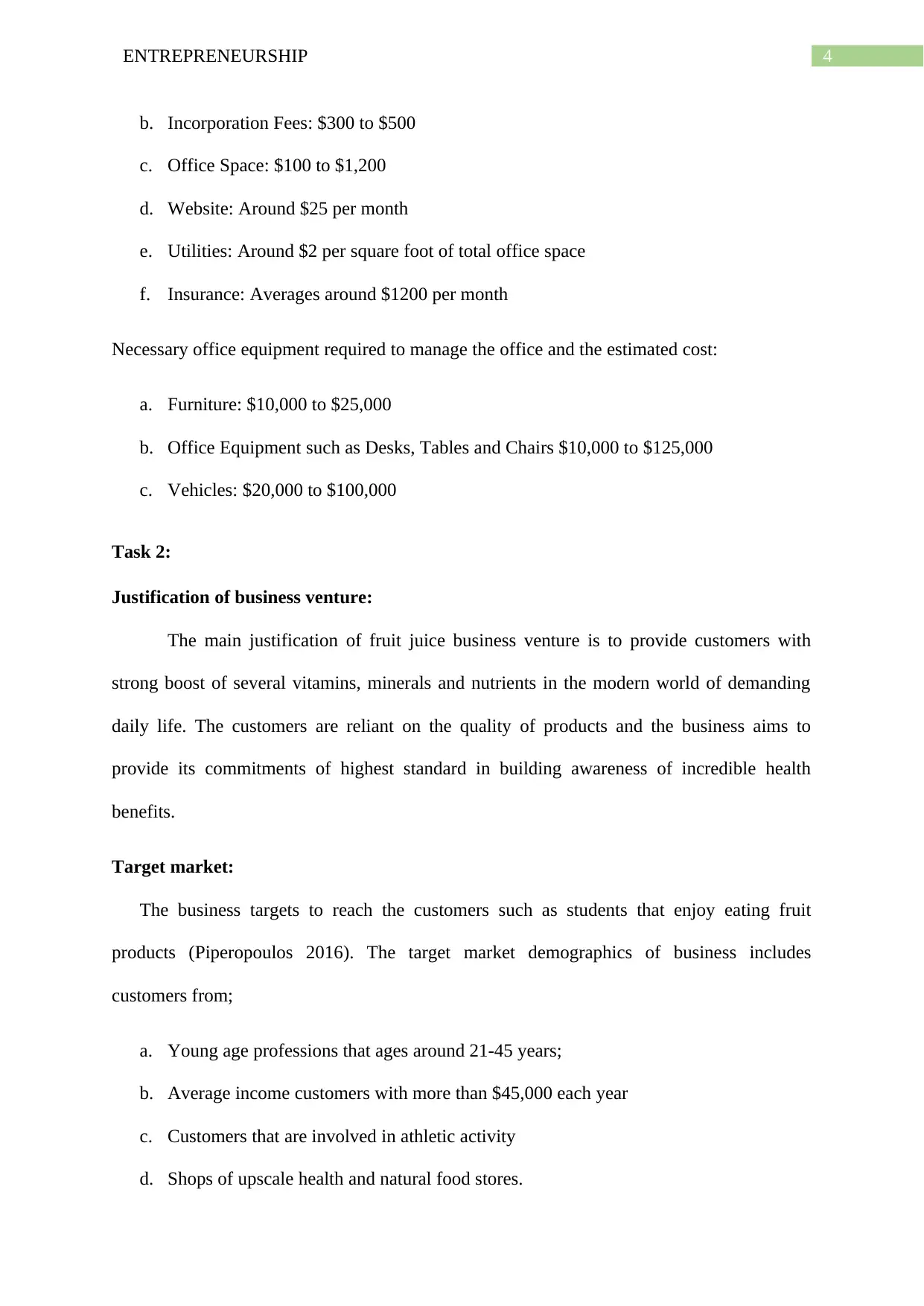
4ENTREPRENEURSHIP
b. Incorporation Fees: $300 to $500
c. Office Space: $100 to $1,200
d. Website: Around $25 per month
e. Utilities: Around $2 per square foot of total office space
f. Insurance: Averages around $1200 per month
Necessary office equipment required to manage the office and the estimated cost:
a. Furniture: $10,000 to $25,000
b. Office Equipment such as Desks, Tables and Chairs $10,000 to $125,000
c. Vehicles: $20,000 to $100,000
Task 2:
Justification of business venture:
The main justification of fruit juice business venture is to provide customers with
strong boost of several vitamins, minerals and nutrients in the modern world of demanding
daily life. The customers are reliant on the quality of products and the business aims to
provide its commitments of highest standard in building awareness of incredible health
benefits.
Target market:
The business targets to reach the customers such as students that enjoy eating fruit
products (Piperopoulos 2016). The target market demographics of business includes
customers from;
a. Young age professions that ages around 21-45 years;
b. Average income customers with more than $45,000 each year
c. Customers that are involved in athletic activity
d. Shops of upscale health and natural food stores.
b. Incorporation Fees: $300 to $500
c. Office Space: $100 to $1,200
d. Website: Around $25 per month
e. Utilities: Around $2 per square foot of total office space
f. Insurance: Averages around $1200 per month
Necessary office equipment required to manage the office and the estimated cost:
a. Furniture: $10,000 to $25,000
b. Office Equipment such as Desks, Tables and Chairs $10,000 to $125,000
c. Vehicles: $20,000 to $100,000
Task 2:
Justification of business venture:
The main justification of fruit juice business venture is to provide customers with
strong boost of several vitamins, minerals and nutrients in the modern world of demanding
daily life. The customers are reliant on the quality of products and the business aims to
provide its commitments of highest standard in building awareness of incredible health
benefits.
Target market:
The business targets to reach the customers such as students that enjoy eating fruit
products (Piperopoulos 2016). The target market demographics of business includes
customers from;
a. Young age professions that ages around 21-45 years;
b. Average income customers with more than $45,000 each year
c. Customers that are involved in athletic activity
d. Shops of upscale health and natural food stores.
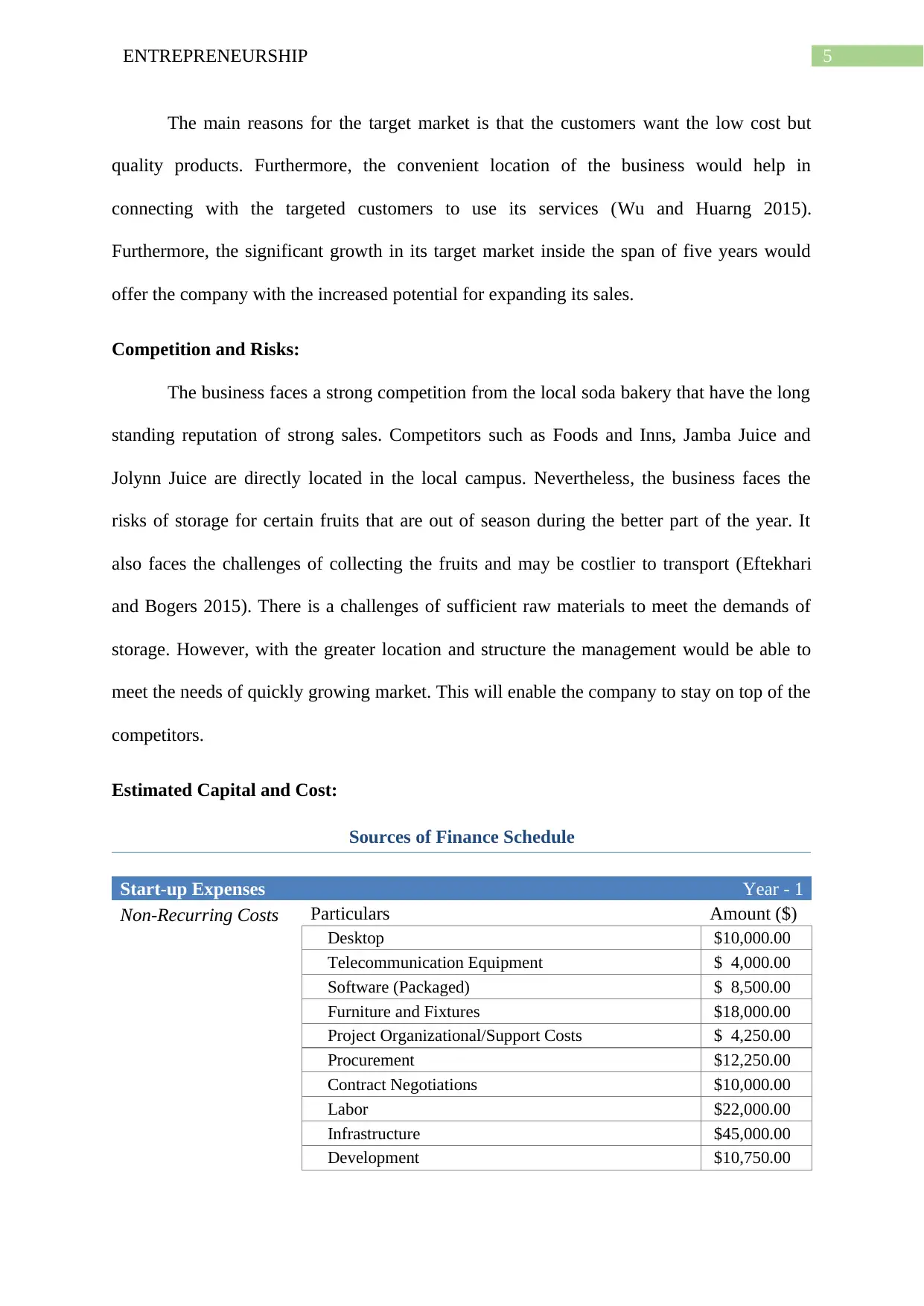
5ENTREPRENEURSHIP
The main reasons for the target market is that the customers want the low cost but
quality products. Furthermore, the convenient location of the business would help in
connecting with the targeted customers to use its services (Wu and Huarng 2015).
Furthermore, the significant growth in its target market inside the span of five years would
offer the company with the increased potential for expanding its sales.
Competition and Risks:
The business faces a strong competition from the local soda bakery that have the long
standing reputation of strong sales. Competitors such as Foods and Inns, Jamba Juice and
Jolynn Juice are directly located in the local campus. Nevertheless, the business faces the
risks of storage for certain fruits that are out of season during the better part of the year. It
also faces the challenges of collecting the fruits and may be costlier to transport (Eftekhari
and Bogers 2015). There is a challenges of sufficient raw materials to meet the demands of
storage. However, with the greater location and structure the management would be able to
meet the needs of quickly growing market. This will enable the company to stay on top of the
competitors.
Estimated Capital and Cost:
Sources of Finance Schedule
Start-up Expenses Year - 1
Non-Recurring Costs Particulars Amount ($)
Desktop $10,000.00
Telecommunication Equipment $ 4,000.00
Software (Packaged) $ 8,500.00
Furniture and Fixtures $18,000.00
Project Organizational/Support Costs $ 4,250.00
Procurement $12,250.00
Contract Negotiations $10,000.00
Labor $22,000.00
Infrastructure $45,000.00
Development $10,750.00
The main reasons for the target market is that the customers want the low cost but
quality products. Furthermore, the convenient location of the business would help in
connecting with the targeted customers to use its services (Wu and Huarng 2015).
Furthermore, the significant growth in its target market inside the span of five years would
offer the company with the increased potential for expanding its sales.
Competition and Risks:
The business faces a strong competition from the local soda bakery that have the long
standing reputation of strong sales. Competitors such as Foods and Inns, Jamba Juice and
Jolynn Juice are directly located in the local campus. Nevertheless, the business faces the
risks of storage for certain fruits that are out of season during the better part of the year. It
also faces the challenges of collecting the fruits and may be costlier to transport (Eftekhari
and Bogers 2015). There is a challenges of sufficient raw materials to meet the demands of
storage. However, with the greater location and structure the management would be able to
meet the needs of quickly growing market. This will enable the company to stay on top of the
competitors.
Estimated Capital and Cost:
Sources of Finance Schedule
Start-up Expenses Year - 1
Non-Recurring Costs Particulars Amount ($)
Desktop $10,000.00
Telecommunication Equipment $ 4,000.00
Software (Packaged) $ 8,500.00
Furniture and Fixtures $18,000.00
Project Organizational/Support Costs $ 4,250.00
Procurement $12,250.00
Contract Negotiations $10,000.00
Labor $22,000.00
Infrastructure $45,000.00
Development $10,750.00
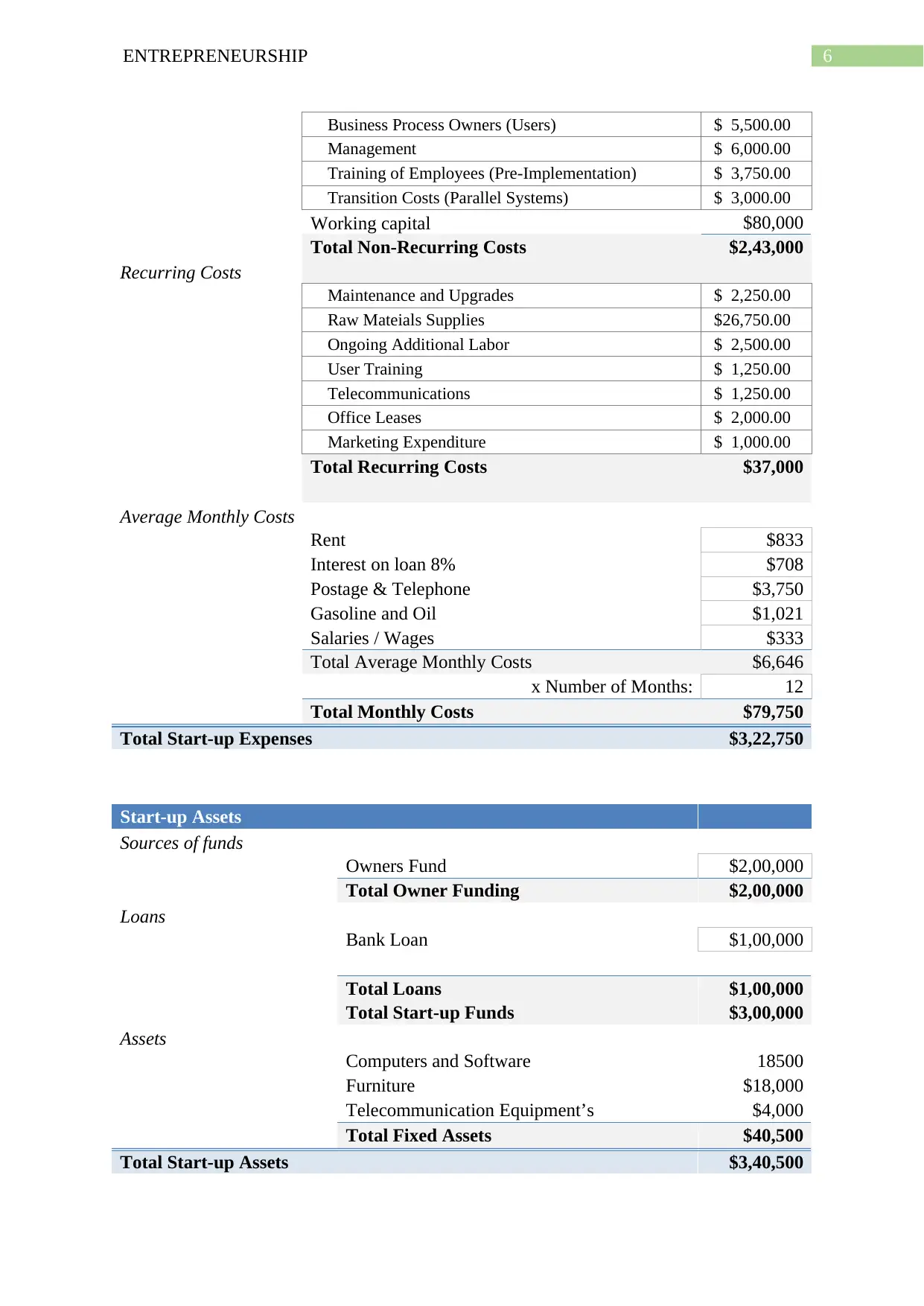
6ENTREPRENEURSHIP
Business Process Owners (Users) $ 5,500.00
Management $ 6,000.00
Training of Employees (Pre-Implementation) $ 3,750.00
Transition Costs (Parallel Systems) $ 3,000.00
Working capital $80,000
Total Non-Recurring Costs $2,43,000
Recurring Costs
Maintenance and Upgrades $ 2,250.00
Raw Mateials Supplies $26,750.00
Ongoing Additional Labor $ 2,500.00
User Training $ 1,250.00
Telecommunications $ 1,250.00
Office Leases $ 2,000.00
Marketing Expenditure $ 1,000.00
Total Recurring Costs $37,000
Average Monthly Costs
Rent $833
Interest on loan 8% $708
Postage & Telephone $3,750
Gasoline and Oil $1,021
Salaries / Wages $333
Total Average Monthly Costs $6,646
x Number of Months: 12
Total Monthly Costs $79,750
Total Start-up Expenses $3,22,750
Start-up Assets
Sources of funds
Owners Fund $2,00,000
Total Owner Funding $2,00,000
Loans
Bank Loan $1,00,000
Total Loans $1,00,000
Total Start-up Funds $3,00,000
Assets
Computers and Software 18500
Furniture $18,000
Telecommunication Equipment’s $4,000
Total Fixed Assets $40,500
Total Start-up Assets $3,40,500
Business Process Owners (Users) $ 5,500.00
Management $ 6,000.00
Training of Employees (Pre-Implementation) $ 3,750.00
Transition Costs (Parallel Systems) $ 3,000.00
Working capital $80,000
Total Non-Recurring Costs $2,43,000
Recurring Costs
Maintenance and Upgrades $ 2,250.00
Raw Mateials Supplies $26,750.00
Ongoing Additional Labor $ 2,500.00
User Training $ 1,250.00
Telecommunications $ 1,250.00
Office Leases $ 2,000.00
Marketing Expenditure $ 1,000.00
Total Recurring Costs $37,000
Average Monthly Costs
Rent $833
Interest on loan 8% $708
Postage & Telephone $3,750
Gasoline and Oil $1,021
Salaries / Wages $333
Total Average Monthly Costs $6,646
x Number of Months: 12
Total Monthly Costs $79,750
Total Start-up Expenses $3,22,750
Start-up Assets
Sources of funds
Owners Fund $2,00,000
Total Owner Funding $2,00,000
Loans
Bank Loan $1,00,000
Total Loans $1,00,000
Total Start-up Funds $3,00,000
Assets
Computers and Software 18500
Furniture $18,000
Telecommunication Equipment’s $4,000
Total Fixed Assets $40,500
Total Start-up Assets $3,40,500
Paraphrase This Document
Need a fresh take? Get an instant paraphrase of this document with our AI Paraphraser
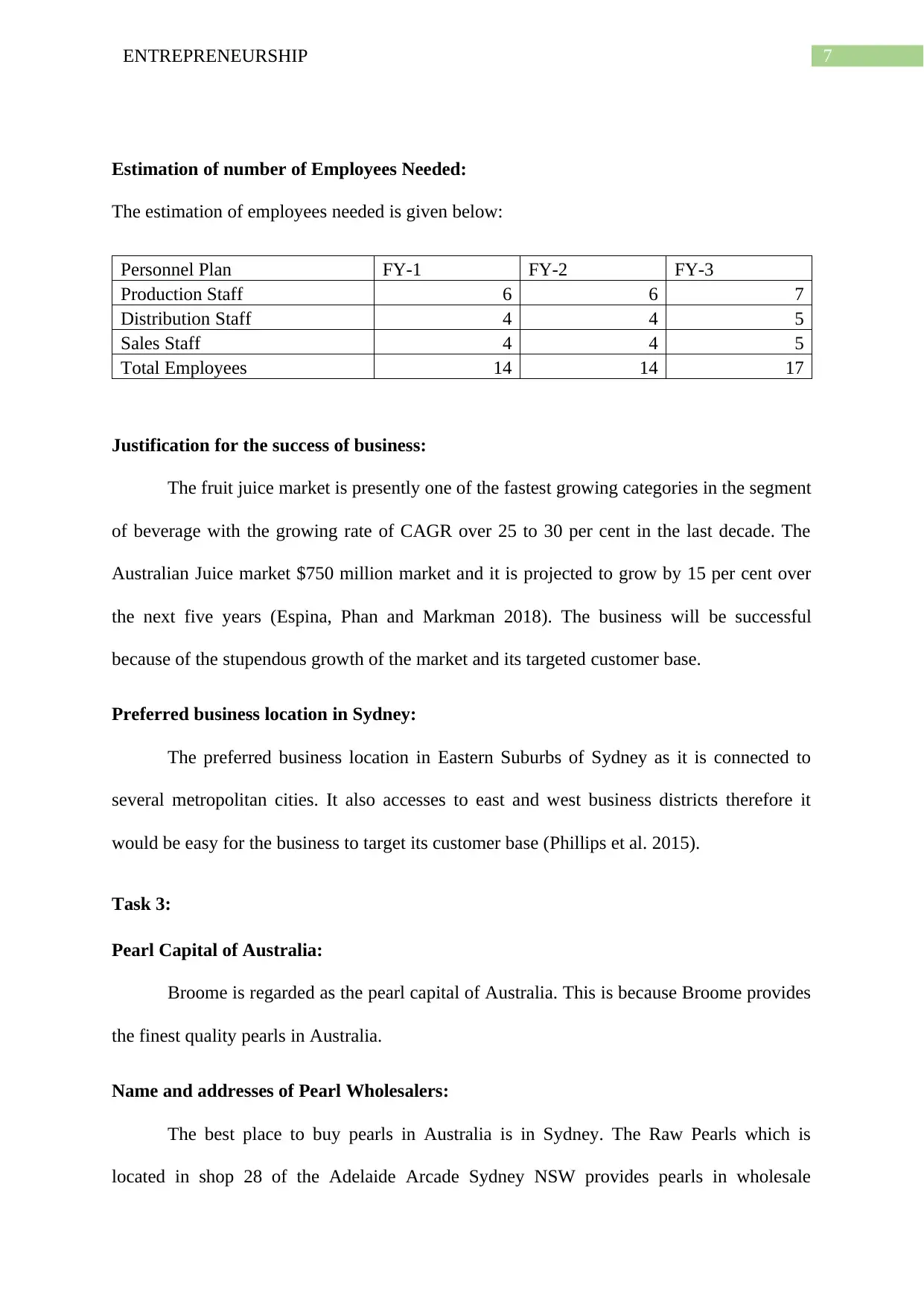
7ENTREPRENEURSHIP
Estimation of number of Employees Needed:
The estimation of employees needed is given below:
Personnel Plan FY-1 FY-2 FY-3
Production Staff 6 6 7
Distribution Staff 4 4 5
Sales Staff 4 4 5
Total Employees 14 14 17
Justification for the success of business:
The fruit juice market is presently one of the fastest growing categories in the segment
of beverage with the growing rate of CAGR over 25 to 30 per cent in the last decade. The
Australian Juice market $750 million market and it is projected to grow by 15 per cent over
the next five years (Espina, Phan and Markman 2018). The business will be successful
because of the stupendous growth of the market and its targeted customer base.
Preferred business location in Sydney:
The preferred business location in Eastern Suburbs of Sydney as it is connected to
several metropolitan cities. It also accesses to east and west business districts therefore it
would be easy for the business to target its customer base (Phillips et al. 2015).
Task 3:
Pearl Capital of Australia:
Broome is regarded as the pearl capital of Australia. This is because Broome provides
the finest quality pearls in Australia.
Name and addresses of Pearl Wholesalers:
The best place to buy pearls in Australia is in Sydney. The Raw Pearls which is
located in shop 28 of the Adelaide Arcade Sydney NSW provides pearls in wholesale
Estimation of number of Employees Needed:
The estimation of employees needed is given below:
Personnel Plan FY-1 FY-2 FY-3
Production Staff 6 6 7
Distribution Staff 4 4 5
Sales Staff 4 4 5
Total Employees 14 14 17
Justification for the success of business:
The fruit juice market is presently one of the fastest growing categories in the segment
of beverage with the growing rate of CAGR over 25 to 30 per cent in the last decade. The
Australian Juice market $750 million market and it is projected to grow by 15 per cent over
the next five years (Espina, Phan and Markman 2018). The business will be successful
because of the stupendous growth of the market and its targeted customer base.
Preferred business location in Sydney:
The preferred business location in Eastern Suburbs of Sydney as it is connected to
several metropolitan cities. It also accesses to east and west business districts therefore it
would be easy for the business to target its customer base (Phillips et al. 2015).
Task 3:
Pearl Capital of Australia:
Broome is regarded as the pearl capital of Australia. This is because Broome provides
the finest quality pearls in Australia.
Name and addresses of Pearl Wholesalers:
The best place to buy pearls in Australia is in Sydney. The Raw Pearls which is
located in shop 28 of the Adelaide Arcade Sydney NSW provides pearls in wholesale
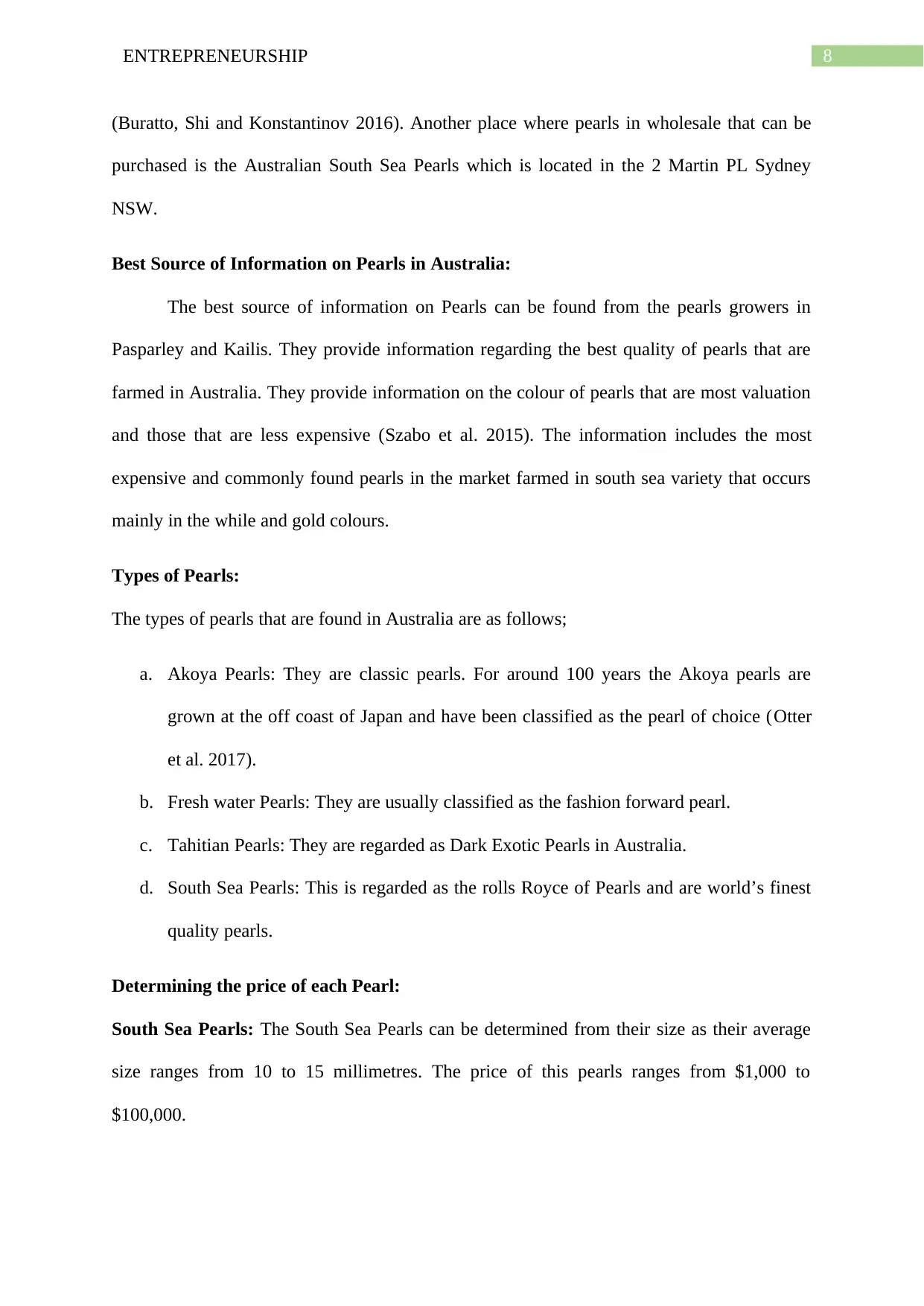
8ENTREPRENEURSHIP
(Buratto, Shi and Konstantinov 2016). Another place where pearls in wholesale that can be
purchased is the Australian South Sea Pearls which is located in the 2 Martin PL Sydney
NSW.
Best Source of Information on Pearls in Australia:
The best source of information on Pearls can be found from the pearls growers in
Pasparley and Kailis. They provide information regarding the best quality of pearls that are
farmed in Australia. They provide information on the colour of pearls that are most valuation
and those that are less expensive (Szabo et al. 2015). The information includes the most
expensive and commonly found pearls in the market farmed in south sea variety that occurs
mainly in the while and gold colours.
Types of Pearls:
The types of pearls that are found in Australia are as follows;
a. Akoya Pearls: They are classic pearls. For around 100 years the Akoya pearls are
grown at the off coast of Japan and have been classified as the pearl of choice (Otter
et al. 2017).
b. Fresh water Pearls: They are usually classified as the fashion forward pearl.
c. Tahitian Pearls: They are regarded as Dark Exotic Pearls in Australia.
d. South Sea Pearls: This is regarded as the rolls Royce of Pearls and are world’s finest
quality pearls.
Determining the price of each Pearl:
South Sea Pearls: The South Sea Pearls can be determined from their size as their average
size ranges from 10 to 15 millimetres. The price of this pearls ranges from $1,000 to
$100,000.
(Buratto, Shi and Konstantinov 2016). Another place where pearls in wholesale that can be
purchased is the Australian South Sea Pearls which is located in the 2 Martin PL Sydney
NSW.
Best Source of Information on Pearls in Australia:
The best source of information on Pearls can be found from the pearls growers in
Pasparley and Kailis. They provide information regarding the best quality of pearls that are
farmed in Australia. They provide information on the colour of pearls that are most valuation
and those that are less expensive (Szabo et al. 2015). The information includes the most
expensive and commonly found pearls in the market farmed in south sea variety that occurs
mainly in the while and gold colours.
Types of Pearls:
The types of pearls that are found in Australia are as follows;
a. Akoya Pearls: They are classic pearls. For around 100 years the Akoya pearls are
grown at the off coast of Japan and have been classified as the pearl of choice (Otter
et al. 2017).
b. Fresh water Pearls: They are usually classified as the fashion forward pearl.
c. Tahitian Pearls: They are regarded as Dark Exotic Pearls in Australia.
d. South Sea Pearls: This is regarded as the rolls Royce of Pearls and are world’s finest
quality pearls.
Determining the price of each Pearl:
South Sea Pearls: The South Sea Pearls can be determined from their size as their average
size ranges from 10 to 15 millimetres. The price of this pearls ranges from $1,000 to
$100,000.
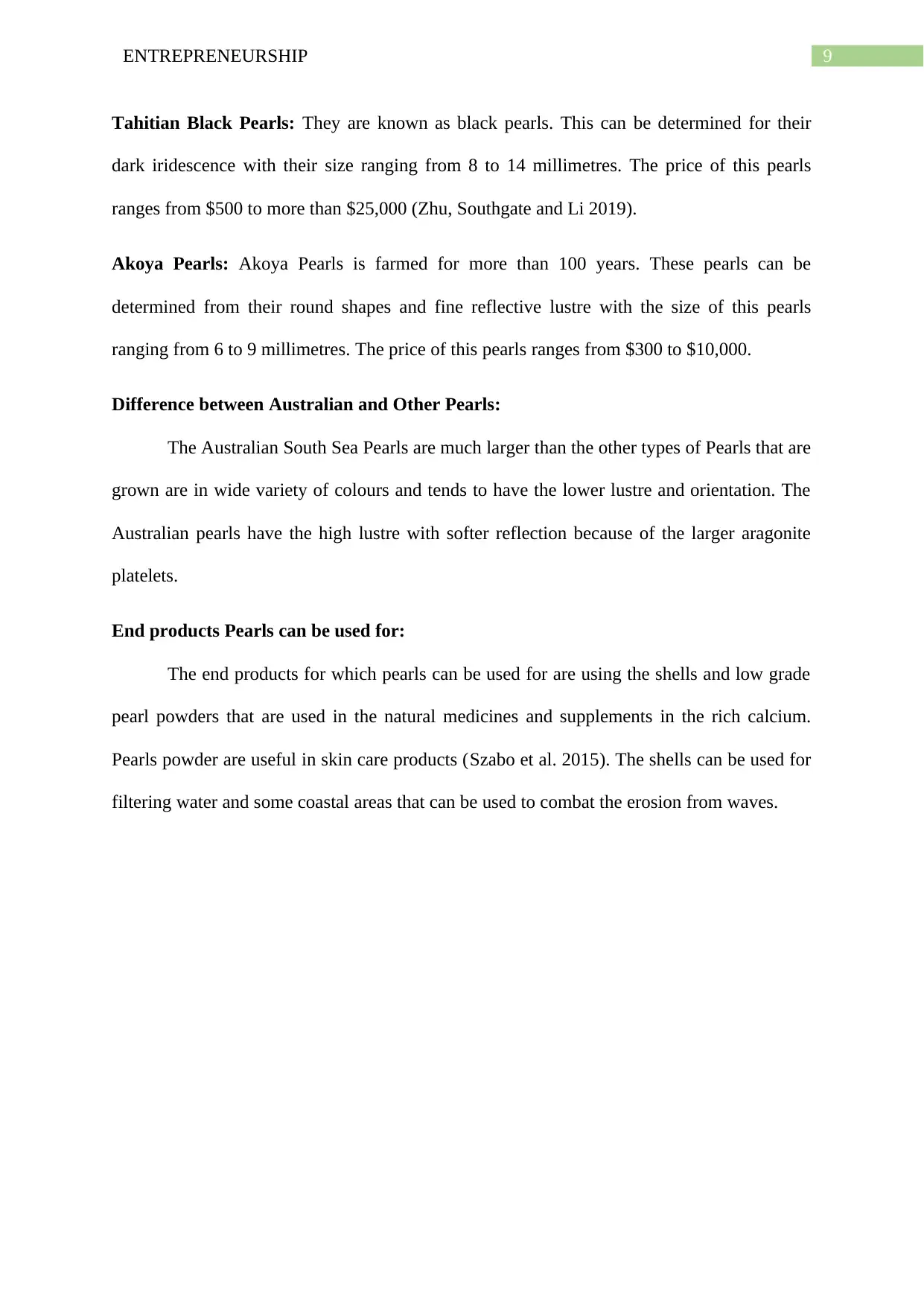
9ENTREPRENEURSHIP
Tahitian Black Pearls: They are known as black pearls. This can be determined for their
dark iridescence with their size ranging from 8 to 14 millimetres. The price of this pearls
ranges from $500 to more than $25,000 (Zhu, Southgate and Li 2019).
Akoya Pearls: Akoya Pearls is farmed for more than 100 years. These pearls can be
determined from their round shapes and fine reflective lustre with the size of this pearls
ranging from 6 to 9 millimetres. The price of this pearls ranges from $300 to $10,000.
Difference between Australian and Other Pearls:
The Australian South Sea Pearls are much larger than the other types of Pearls that are
grown are in wide variety of colours and tends to have the lower lustre and orientation. The
Australian pearls have the high lustre with softer reflection because of the larger aragonite
platelets.
End products Pearls can be used for:
The end products for which pearls can be used for are using the shells and low grade
pearl powders that are used in the natural medicines and supplements in the rich calcium.
Pearls powder are useful in skin care products (Szabo et al. 2015). The shells can be used for
filtering water and some coastal areas that can be used to combat the erosion from waves.
Tahitian Black Pearls: They are known as black pearls. This can be determined for their
dark iridescence with their size ranging from 8 to 14 millimetres. The price of this pearls
ranges from $500 to more than $25,000 (Zhu, Southgate and Li 2019).
Akoya Pearls: Akoya Pearls is farmed for more than 100 years. These pearls can be
determined from their round shapes and fine reflective lustre with the size of this pearls
ranging from 6 to 9 millimetres. The price of this pearls ranges from $300 to $10,000.
Difference between Australian and Other Pearls:
The Australian South Sea Pearls are much larger than the other types of Pearls that are
grown are in wide variety of colours and tends to have the lower lustre and orientation. The
Australian pearls have the high lustre with softer reflection because of the larger aragonite
platelets.
End products Pearls can be used for:
The end products for which pearls can be used for are using the shells and low grade
pearl powders that are used in the natural medicines and supplements in the rich calcium.
Pearls powder are useful in skin care products (Szabo et al. 2015). The shells can be used for
filtering water and some coastal areas that can be used to combat the erosion from waves.
Secure Best Marks with AI Grader
Need help grading? Try our AI Grader for instant feedback on your assignments.
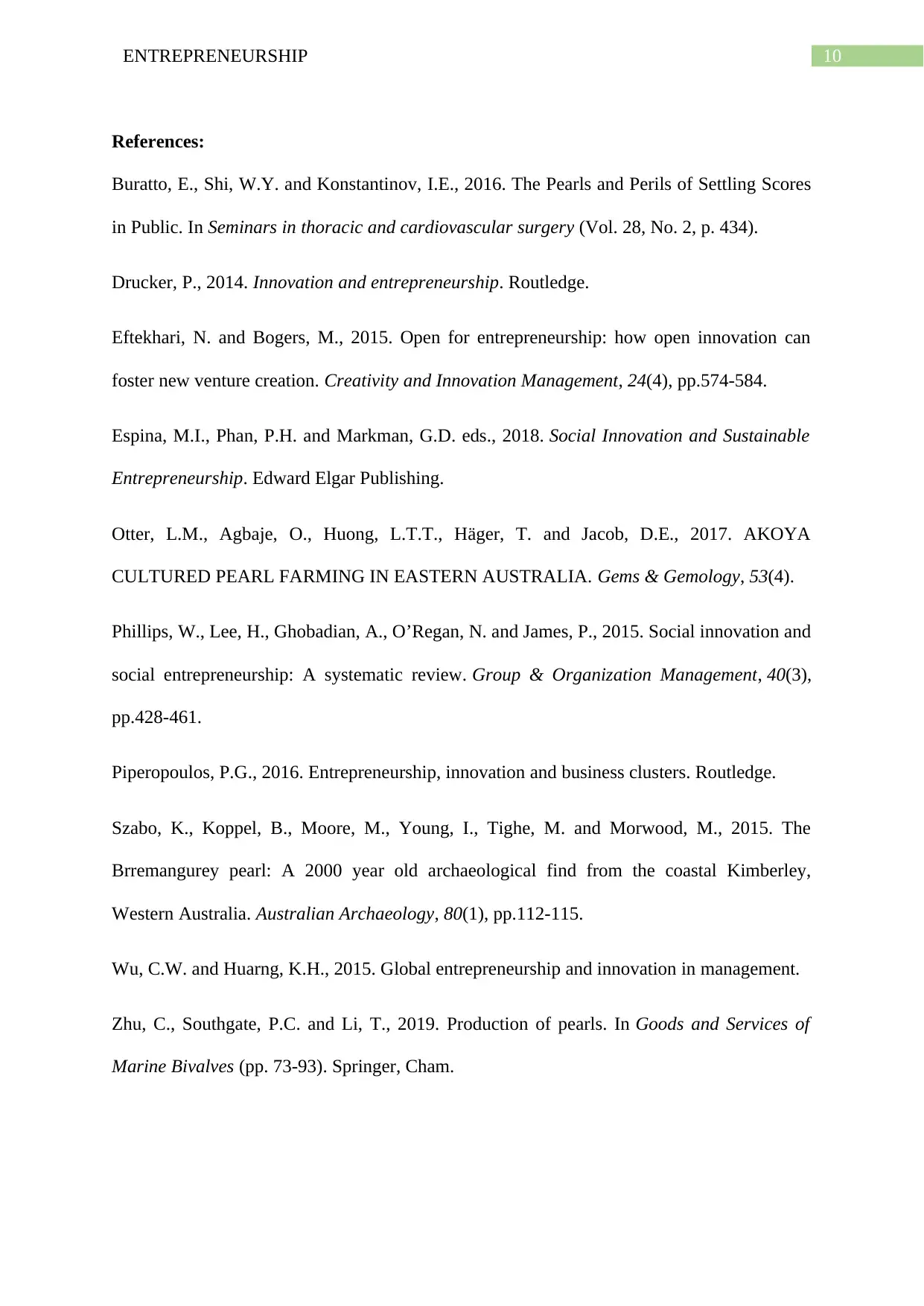
10ENTREPRENEURSHIP
References:
Buratto, E., Shi, W.Y. and Konstantinov, I.E., 2016. The Pearls and Perils of Settling Scores
in Public. In Seminars in thoracic and cardiovascular surgery (Vol. 28, No. 2, p. 434).
Drucker, P., 2014. Innovation and entrepreneurship. Routledge.
Eftekhari, N. and Bogers, M., 2015. Open for entrepreneurship: how open innovation can
foster new venture creation. Creativity and Innovation Management, 24(4), pp.574-584.
Espina, M.I., Phan, P.H. and Markman, G.D. eds., 2018. Social Innovation and Sustainable
Entrepreneurship. Edward Elgar Publishing.
Otter, L.M., Agbaje, O., Huong, L.T.T., Häger, T. and Jacob, D.E., 2017. AKOYA
CULTURED PEARL FARMING IN EASTERN AUSTRALIA. Gems & Gemology, 53(4).
Phillips, W., Lee, H., Ghobadian, A., O’Regan, N. and James, P., 2015. Social innovation and
social entrepreneurship: A systematic review. Group & Organization Management, 40(3),
pp.428-461.
Piperopoulos, P.G., 2016. Entrepreneurship, innovation and business clusters. Routledge.
Szabo, K., Koppel, B., Moore, M., Young, I., Tighe, M. and Morwood, M., 2015. The
Brremangurey pearl: A 2000 year old archaeological find from the coastal Kimberley,
Western Australia. Australian Archaeology, 80(1), pp.112-115.
Wu, C.W. and Huarng, K.H., 2015. Global entrepreneurship and innovation in management.
Zhu, C., Southgate, P.C. and Li, T., 2019. Production of pearls. In Goods and Services of
Marine Bivalves (pp. 73-93). Springer, Cham.
References:
Buratto, E., Shi, W.Y. and Konstantinov, I.E., 2016. The Pearls and Perils of Settling Scores
in Public. In Seminars in thoracic and cardiovascular surgery (Vol. 28, No. 2, p. 434).
Drucker, P., 2014. Innovation and entrepreneurship. Routledge.
Eftekhari, N. and Bogers, M., 2015. Open for entrepreneurship: how open innovation can
foster new venture creation. Creativity and Innovation Management, 24(4), pp.574-584.
Espina, M.I., Phan, P.H. and Markman, G.D. eds., 2018. Social Innovation and Sustainable
Entrepreneurship. Edward Elgar Publishing.
Otter, L.M., Agbaje, O., Huong, L.T.T., Häger, T. and Jacob, D.E., 2017. AKOYA
CULTURED PEARL FARMING IN EASTERN AUSTRALIA. Gems & Gemology, 53(4).
Phillips, W., Lee, H., Ghobadian, A., O’Regan, N. and James, P., 2015. Social innovation and
social entrepreneurship: A systematic review. Group & Organization Management, 40(3),
pp.428-461.
Piperopoulos, P.G., 2016. Entrepreneurship, innovation and business clusters. Routledge.
Szabo, K., Koppel, B., Moore, M., Young, I., Tighe, M. and Morwood, M., 2015. The
Brremangurey pearl: A 2000 year old archaeological find from the coastal Kimberley,
Western Australia. Australian Archaeology, 80(1), pp.112-115.
Wu, C.W. and Huarng, K.H., 2015. Global entrepreneurship and innovation in management.
Zhu, C., Southgate, P.C. and Li, T., 2019. Production of pearls. In Goods and Services of
Marine Bivalves (pp. 73-93). Springer, Cham.

11ENTREPRENEURSHIP
1 out of 12
Related Documents
Your All-in-One AI-Powered Toolkit for Academic Success.
+13062052269
info@desklib.com
Available 24*7 on WhatsApp / Email
![[object Object]](/_next/static/media/star-bottom.7253800d.svg)
Unlock your academic potential
© 2024 | Zucol Services PVT LTD | All rights reserved.




